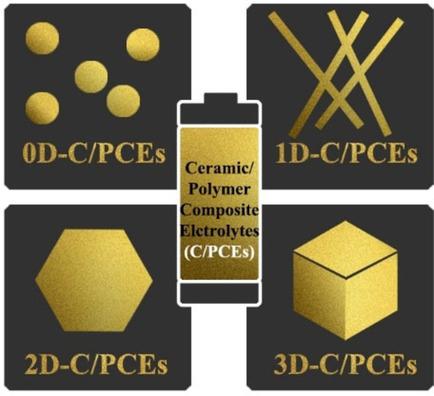当前位置:
X-MOL 学术
›
Batteries Supercaps
›
论文详情
Our official English website, www.x-mol.net, welcomes your
feedback! (Note: you will need to create a separate account there.)
Designing Ceramic/Polymer Composite as Highly Ionic Conductive Solid‐State Electrolytes
Batteries & Supercaps ( IF 5.1 ) Pub Date : 2020-08-05 , DOI: 10.1002/batt.202000149 Shangshu Qian 1 , Hao Chen 1 , Zhenzhen Wu 1 , Dongsheng Li 2 , Xianhu Liu 3 , Yongbing Tang 4 , Shanqing Zhang 1
Batteries & Supercaps ( IF 5.1 ) Pub Date : 2020-08-05 , DOI: 10.1002/batt.202000149 Shangshu Qian 1 , Hao Chen 1 , Zhenzhen Wu 1 , Dongsheng Li 2 , Xianhu Liu 3 , Yongbing Tang 4 , Shanqing Zhang 1
Affiliation

|
The design and fabrication of solid‐state electrolytes (SSEs) with high ionic conductivity is the most crucial obstacle for all‐solid‐state lithium batteries (ASSLBs). However, though polymer SSEs have the advantages of effective interfacial contact, polymer ASSLBs have not been able to deliver performance comparable to conventional lithium‐ion batteries (LIBs) due to slow ion transport within the polymer framework. In contrast, the high inherent ionic conductivity of ceramic SSEs is limited by the poor electrolyte/electrode interfacial contact. Therefore, the concept of ceramic/polymer composite electrolytes (C/PCEs) was proposed to combine the advantages of these two electrolytes and simultaneously overcome their weaknesses. This work reviews the recent progress in C/PCEs development according to the morphology of the ceramic components in C/PCEs. In this review, we investigate the inherent relationship between the structures of C/PCEs and the performance of the resultant SSEs, and subsequently conclude some general C/PCE design principles for future SSEs.
中文翻译:

将陶瓷/聚合物复合材料设计为高离子导电固体电解质
高离子电导率的固态电解质(SSE)的设计和制造是全固态锂电池(ASSLB)的最关键的障碍。然而,尽管聚合物SSE具有有效界面接触的优势,但由于聚合物框架内的离子迁移缓慢,聚合物ASSLB无法提供与常规锂离子电池(LIB)相当的性能。相反,陶瓷SSE的高固有离子电导率受到不良的电解质/电极界面接触的限制。因此,提出了陶瓷/聚合物复合电解质(C / PCE)的概念,以结合这两种电解质的优点并同时克服它们的缺点。这项工作根据C / PCE中陶瓷组件的形态,回顾了C / PCE开发中的最新进展。在这篇综述中,我们研究了C / PCE的结构与所得SSE的性能之间的内在联系,然后总结了一些未来CSE的通用C / PCE设计原则。
更新日期:2020-08-05
中文翻译:

将陶瓷/聚合物复合材料设计为高离子导电固体电解质
高离子电导率的固态电解质(SSE)的设计和制造是全固态锂电池(ASSLB)的最关键的障碍。然而,尽管聚合物SSE具有有效界面接触的优势,但由于聚合物框架内的离子迁移缓慢,聚合物ASSLB无法提供与常规锂离子电池(LIB)相当的性能。相反,陶瓷SSE的高固有离子电导率受到不良的电解质/电极界面接触的限制。因此,提出了陶瓷/聚合物复合电解质(C / PCE)的概念,以结合这两种电解质的优点并同时克服它们的缺点。这项工作根据C / PCE中陶瓷组件的形态,回顾了C / PCE开发中的最新进展。在这篇综述中,我们研究了C / PCE的结构与所得SSE的性能之间的内在联系,然后总结了一些未来CSE的通用C / PCE设计原则。











































 京公网安备 11010802027423号
京公网安备 11010802027423号